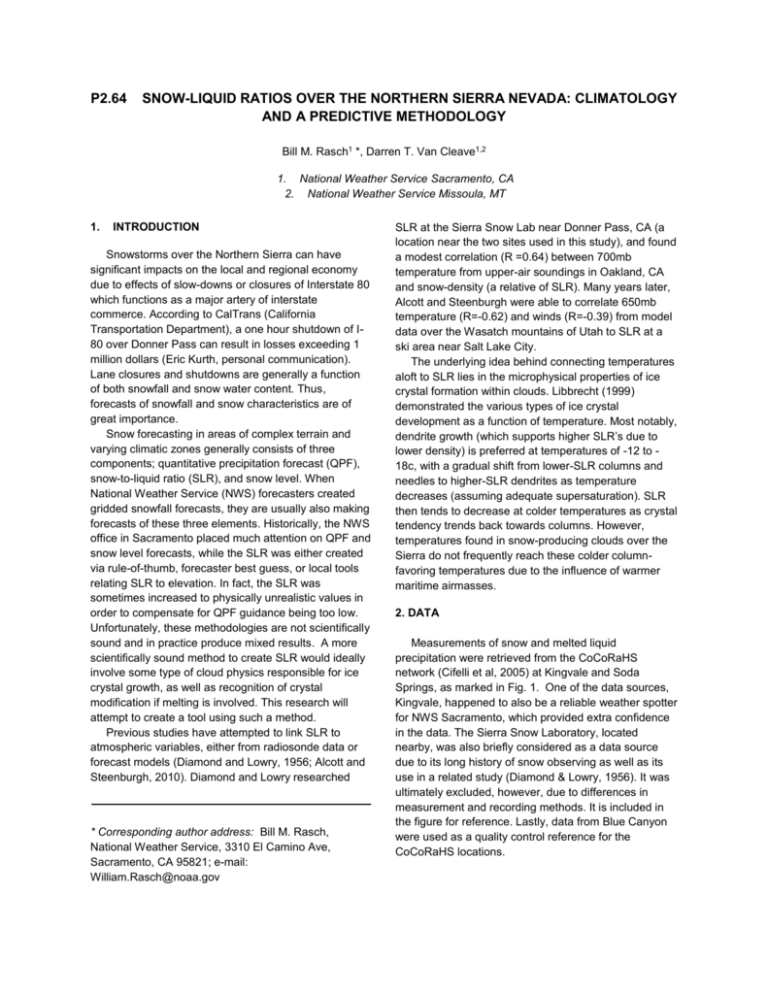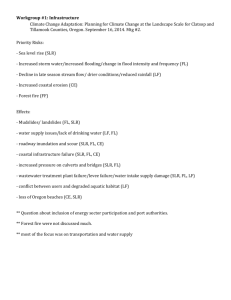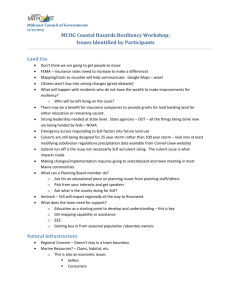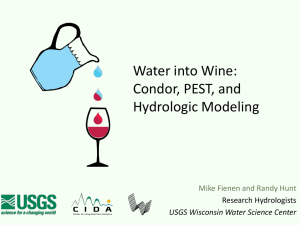P2.64 SNOW-LIQUID RATIOS OVER THE NORTHERN SIERRA
advertisement

P2.64 SNOW-LIQUID RATIOS OVER THE NORTHERN SIERRA NEVADA: CLIMATOLOGY AND A PREDICTIVE METHODOLOGY Bill M. Rasch1 *, Darren T. Van Cleave1,2 1. National Weather Service Sacramento, CA 2. National Weather Service Missoula, MT 1. INTRODUCTION Snowstorms over the Northern Sierra can have significant impacts on the local and regional economy due to effects of slow-downs or closures of Interstate 80 which functions as a major artery of interstate commerce. According to CalTrans (California Transportation Department), a one hour shutdown of I80 over Donner Pass can result in losses exceeding 1 million dollars (Eric Kurth, personal communication). Lane closures and shutdowns are generally a function of both snowfall and snow water content. Thus, forecasts of snowfall and snow characteristics are of great importance. Snow forecasting in areas of complex terrain and varying climatic zones generally consists of three components; quantitative precipitation forecast (QPF), snow-to-liquid ratio (SLR), and snow level. When National Weather Service (NWS) forecasters created gridded snowfall forecasts, they are usually also making forecasts of these three elements. Historically, the NWS office in Sacramento placed much attention on QPF and snow level forecasts, while the SLR was either created via rule-of-thumb, forecaster best guess, or local tools relating SLR to elevation. In fact, the SLR was sometimes increased to physically unrealistic values in order to compensate for QPF guidance being too low. Unfortunately, these methodologies are not scientifically sound and in practice produce mixed results. A more scientifically sound method to create SLR would ideally involve some type of cloud physics responsible for ice crystal growth, as well as recognition of crystal modification if melting is involved. This research will attempt to create a tool using such a method. Previous studies have attempted to link SLR to atmospheric variables, either from radiosonde data or forecast models (Diamond and Lowry, 1956; Alcott and Steenburgh, 2010). Diamond and Lowry researched * Corresponding author address: Bill M. Rasch, National Weather Service, 3310 El Camino Ave, Sacramento, CA 95821; e-mail: William.Rasch@noaa.gov SLR at the Sierra Snow Lab near Donner Pass, CA (a location near the two sites used in this study), and found a modest correlation (R =0.64) between 700mb temperature from upper-air soundings in Oakland, CA and snow-density (a relative of SLR). Many years later, Alcott and Steenburgh were able to correlate 650mb temperature (R=-0.62) and winds (R=-0.39) from model data over the Wasatch mountains of Utah to SLR at a ski area near Salt Lake City. The underlying idea behind connecting temperatures aloft to SLR lies in the microphysical properties of ice crystal formation within clouds. Libbrecht (1999) demonstrated the various types of ice crystal development as a function of temperature. Most notably, dendrite growth (which supports higher SLR’s due to lower density) is preferred at temperatures of -12 to 18c, with a gradual shift from lower-SLR columns and needles to higher-SLR dendrites as temperature decreases (assuming adequate supersaturation). SLR then tends to decrease at colder temperatures as crystal tendency trends back towards columns. However, temperatures found in snow-producing clouds over the Sierra do not frequently reach these colder columnfavoring temperatures due to the influence of warmer maritime airmasses. 2. DATA Measurements of snow and melted liquid precipitation were retrieved from the CoCoRaHS network (Cifelli et al, 2005) at Kingvale and Soda Springs, as marked in Fig. 1. One of the data sources, Kingvale, happened to also be a reliable weather spotter for NWS Sacramento, which provided extra confidence in the data. The Sierra Snow Laboratory, located nearby, was also briefly considered as a data source due to its long history of snow observing as well as its use in a related study (Diamond & Lowry, 1956). It was ultimately excluded, however, due to differences in measurement and recording methods. It is included in the figure for reference. Lastly, data from Blue Canyon were used as a quality control reference for the CoCoRaHS locations. Figure 1 - Location of observations along Interstate 80. Cases of snowfall greater than 2 inches were retrieved for four winter seasons dating back to 2008 for Kingvale and Soda Springs. Cases with mixed rain and snow were removed to eliminate contamination of the dataset. The existence of mixed precipitation was inferred from temperature and weather observations at the nearby Blue Canyon ASOS and weather observations from the Sierra Snow Lab. Blue Canyon lies around a thousand feet lower than CoCoRaHS stations, while the Sierra Snow Lab is around 500 feet higher than the stations. For each case, if the Sierra Snow Lab reported any liquid, the case was thrown out. If Blue Canyon reported all snow, the case was included. If Blue Canyon reported mixed rain and snow while the Sierra Snow Lab reported all snow, the surface temperature at Blue Canyon was interpolated along a moist adiabat to Kingvale’s elevation. If this process yielded below-freezing temperatures, the case was included. Official NWS Sacramento gridded forecasts of snow and QPF were retrieved from local office records through the BOIVerify program commonly used at NWS offices. Unfortunately, this dataset was temporally limited due to disk space constraints, only going as far back as winter 2011. Thus, the full CoCoRaHS dataset was used for examining the SLR climatology, while only the combined period of record dating back to February 2011 was used for the SLR forecasting methodology and verification. 3. SNOW RATIO CLIMATOLOGY Histograms of the overall snow ratios for both sites were created, which showed a median SLR value of 9 with relatively few cases reaching above 20. This is remarkably similar to Baxter et. al (2005) who found an average of 9 over the Sacramento forecast area despite using a much different dataset over a different period of time (30 years of data from NWS cooperative observer data). Histograms by month for one of the stations, Kingvale, are provided in Fig. 2. As would be expected, SLR trends upward towards the colder months in the middle of winter and visa-versa in the spring. While February shows the highest average SLR, December is the month with the most extreme cases of SLR greater than 20. Figure 2 - Kingvale SLR by month. 4. TOOL METHODOLOGY Following Alcott and Steenburgh (2010) and Diamond and Lowry (1954), four winter seasons of CoCoRaHS SLR data were correlated to modeled winds and temperatures aloft. The North American Regional Reanalysis (NARR; Mesinger et al. 2006) model was selected due to its temporal coverage and ease of use. Figure 3 - 700mb temperature versus SLR at Soda Springs. A grid point between Kingvale and Soda Springs was selected to be the representative model point. Winds and temperatures from 800-600mb were tested for correlation with SLR at both Kingvale and Soda Springs. Before correlations were computed, the CoCoRaHS data was filtered by removing SLRs more than four standard deviations from the mean (this removed the few strongest outliers which may have been bad data points). The best correlations for both wind magnitude and temperature were found at 700mb; this happens to be the same geopotential height used by Diamond and Lowry (1954). Fig. 3 shows the 700mb correlation to SLR at Soda Springs, which exhibits a nearly uniform spread across all 700mb temperatures. While this 700mb relationship works reasonably well for ice crystals unaltered during their decent to the surface, modification by elevated warm layers, refreezing in surface cold pools, and many other interactions can introduce additional challenges. For the western slope of the Northern Sierra Nevada, melting of snow at lower elevations and eventual transition to rain is a common feature of virtually all winter storms in the area. Thus, an SLR methodology should include some acknowledgement of the contribution of surface conditions. Local NWS Sacramento forecasting knowledge as well as previous research shows that SLR has some relationship with surface temperature (Judson and Doesken, 2000). For this study, hourly temperature forecasts were compared to SLR data, with the hourly temperatures averaged over 12 hour periods. A modest correlation of R2=0.41 at Kingvale and 0.27 at Soda Springs was found. This result is within range of the findings of Judson & Doesken (R2=0.27, 2000). While the correlation is not as strong and consistent as the 700mb relationship, it was considered robust enough to be used as a second component to an eventual SLR forecasting tool. Figure 4 - Conceptual schematic of SLR tool A conceptual model for a SLR forecasting tool is depicted in Fig. 4. The 700mb relationship is used at elevations above the snow level (and for below-freezing temperatures in the hourly weather grids) where cloud physics are the driving factor in SLR; below this level, the surface relationship is used. By connecting SLR to surface temperature near the freezing level, interelement consistency between the weather, hourly temperature, snow amount, and snow level grids is preserved (assuming the snow level grid is used to create the rain/snow transition zone in the Figure 5 – Magnitude of errors in snow forecasts at Kingvale from 11/2011 to 3/2013. Each point is an event with > 2”. weather grid). A tool was created at NWS Sacramento within the Graphical Forecast Editor (GFE) to perform the previously mentioned methodology. With default settings, this tool calculates SLR at all locations using the 700mb relationship, calculates SLR using the surface temperature relationship where the average hourly temperature is forecasted to be below 35, divides SLR in half where the weather grid contains mixed rain and snow, and removes SLR where the weather grid contains no snow. Several options are provided to the forecaster, including the selection of models for the 700mb portion and the ability to select the 700mb or surface relationships only. This helps to encompass the wide range of operational situations which fall outside the bounds assumed in the aforementioned conceptual model. 5. RESULTS Using the methodology described above, output from the SLR tool was compared to official NWS forecasts. The forecast errors (|observed-forecasted|) for both the NWS forecast and the SLR tool forecast at Kingvale are plotted in Figure 5. While the SLR tool does not always perform better than the official forecast (actually performing worse on occasion), it does, on average, reduce the magnitude of errors, particularly the ‘big busts’ (errors > 15 inches). Considering both Kingvale and Soda Springs together for winter 2011, the SLR tool offered an average 22% reduction in forecast error. More notably, for cases over 10 inches, the tool yielded average improvements of 32%. Results of the GFE tool are shown in Fig. 6 for a snow event in December 2012. The official forecast using the new tool resulted in a far better snow forecast, which also happened to better coordinate with a neighboring NWS forecast office. 6. FUTURE IMPROVEMENTS While this GFE tool represents an improvement in the scientific integrity of SLR forecasts and resulting snow forecasts, it has multiple areas for improvement. Practical limitations in this research project prevented the direct use of NAM, GFS, and ECMWF forecasts; namely, those models were not easily available for quick download via scripts as was the NARR. The GFE tool created through this research thus makes the inherent assumption that correlations of NARR data to SLR are applicable for other models; this may not necessarily be the case. Ideally, each model would need its own set of correlations. Fortunately, the NAM model is fairly similar to the NARR as the NARR’s physics consist of the NAM as used in the early 2000’s (Messinger, 2006). Another weakness in forming this tool is using one climatic zone to forecast SLR for an entire forecast area. Unfortunately, there are not many sites in the Sierra which have reliable snowfall and melted snow data on a routine basis, particularly at the higher elevations such as Donner Pass. Ideally, data would be retrieved for several points representing the various climatic zones of the forecast area, and correlations could then be included in the tool which would vary spatially and allow for appropriate climatological variability within the forecast domain. With plentiful data, correlations could even be performed for different seasons to add another layer of precision. Figure 6 - Upper panels: SLR and snow forecasts within GFE using existing methodologies for a December storm. Lower panel: same forecasts, except using SLRs created with the new tool. One particular difficulty encountered in forming the tool was handling the transition from the 700mb relationship to the surface relationship. Ideally, the tool would transition from one method to the other via a small transition zone where the rate of change of the values is tied to the topography. This was beyond the skills of those working on this project, so instead the tool creates masks for each portions, then simply overlays them. This can create a rapid transition in SLR from higher to lower values as elevation decreases, which may not be reflective of nature. After testing the 700mb relationship, surface relationship, and various models and blends within the tool over early winter 2012/2013, it quickly became apparent that a one-size-fits-all approach to the tool options was simply impossible. After testing, the optimal approach was to allow some options to the forecaster to tailor the tool to the situation (as opposed to a “black box” approach where the forecaster simply runs a tool with default selections built in and no options allowed). ACKNOWLEDGEMENTS Local undergraduate volunteers at NWS Sacramento Brian Rico and Matt Little collected data for the study. Also, NWS Sacramento forecaster Eric Kurth retrieved data from CalTrans and the Sierra Snow Lab. Cifelli, R., N. Doesken, P. Kennedy, L. D. Carey, S. Rutledge, C. Gimmestad, and T. Depue. 2005. The community collaborative rain, hail, and snow network. Bull. Amer. Meteor. Soc, 86:1069–1077. Diamond, M., and W. P. Lowry, 1954: Correlation of density of new snow with 700-millibar temperature. J. Meteor., 11, 512–513. REFERENCES Judson, A., and N. Doesken, 2000: Density of freshly fallen snow in the central Rocky Mountains. Bull. Amer. Meteor. Soc., 81, 1577–1587. Alcott, T. I., and W. J. Steenburgh, 2010: Snow-to-liquid variability and prediction at a high-elevation site in Utah’s Wasatch Mountains. Wea. Forecasting, 25, 323– 337. Libbrecht, K. G., 1999: A Guide to Snowflakes. [Available on line at: http://www.its.caltech.edu/~atomic/snowcrystals/]. Baxter, A. M., C. E. Graves, and J. T. Moore, 2005: A climatology of snow-to-liquid ratio for the contiguous United States. Wea. Forecasting, 20, 729–744. Mesinger, F., and Coauthors, 2006: North American regional reanalysis. Bull. Amer. Meteor. Soc., 87, 343– 360.








